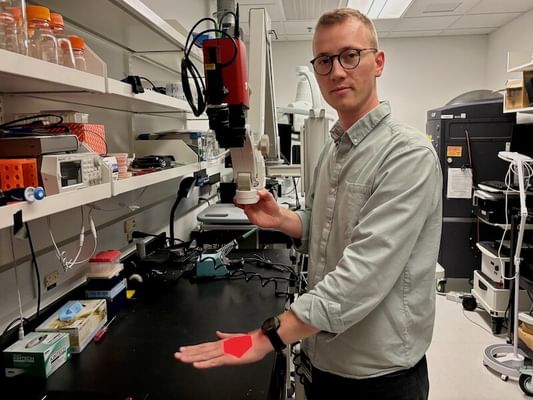- Undergraduate
Bachelor's Degrees
Bachelor of ArtsBachelor of EngineeringDual-Degree ProgramUndergraduate AdmissionsUndergraduate Experience
- Graduate
Graduate Experience
- Research
- Entrepreneurship
- Community
- About
-
Search
All Thayer News

Biomedical Engineers Develop New Way to Help Surgeons See Cancer
Aug 14, 2024 | by Catha Mayor
A new method to help surgeons distinguish cancer from healthy tissue in real time is closer to reality thanks to a joint effort by researchers at Dartmouth Engineering and the University of Wisconsin-Madison Dept. of Medical Physics. Their results, published today in the Proceedings of the National Academy of Sciences (PNAS), demonstrate a way to use pressure to reveal diseased tissue with poor vasculature, characterized by low oxygen levels—a hallmark of many malignant tumors.

Dartmouth Engineering researcher Arthur Pétusseau Th'23 demos the PRESTO camera. (Photo by Catha Mayor)
"Even in normal tissue, applying pressure reduces blood flow, and therefore tissue oxygen levels," says Arthur Pétusseau Th'23, a Dartmouth Engineering researcher and the study's first author. "It's like when you press a finger into the skin of your hand and then release it—you can see the blood return quickly. But in tumors, that effect is sustained because the blood flow in tumors is much slower. While normal tissue can re-oxygenate in a couple of seconds, a tumor can take up to five minutes. We leverage this difference to create high contrast between malignant and normal tissue."
The most aggressive, fastest-growing tumors tend to have the least efficient blood flow, making them more prone to oxygen deficiency, known as hypoxia. The researchers developed an imaging system capable of measuring tissue oxygen variations when a surgeon applies pressure to tissue. The system utilizes a specialized camera to capture the fluorescent signals emitted by an imaging agent activated by hypoxia.
"While there are many oxygen-measuring devices out there—like the blood oxygen saturation probes you see on smartwatches—what makes our technology unique is that it maps intracellular oxygen distribution and gives real-time feedback to the surgeon," says Pétusseau. "That makes it potentially usable for many different applications, not only for surgery, but also for any case where hypoxia is an indicator of diseased tissue."
The system was named, "Pressure-Enhanced Sensing of Tissue Oxygenation," or "PRESTO." For Pétusseau, the name was serendipitous. "Not being a native English speaker, I didn't know that 'presto' is what magicians say when they reveal something. But that's kind of what this technique is—the signal that appears in the tumor after pressure is applied to the tissue."
The team is just starting a human clinical study of PRESTO working with the Department of Dermatology at Dartmouth Health. "One of the key advantages of this technology is that, because it relies on tissue oxygen content rather than just the distribution of the imaging agent in the tissue, it can be used for any type of tumor in the body," continues Pétusseau. "We think skin is a good first avenue to test our technology in real-case conditions, as the imaging agent used in PRESTO is already a standard part of skin cancer treatment, and because skin cancer is one of the most common cancers in the US."
"This work by our Wisconsin and Dartmouth groups has high value in surgical guidance and is the result of years of effort, especially by lead authors Arthur and Marien Ochoa," says Brian Pogue, adjunct professor of engineering at Dartmouth, professor of medical physics at University of Wisconsin-Madison, and president and co-founder of DoseOptics—a radiotherapy imaging technology company founded and run by several of Pétusseau's colleagues.
In fact, the PRESTO camera is based on the core of the DoseOptics camera, with modified acquisition timing that enables real-time imaging. The success of PRESTO, along with the entrepreneurial example set by DoseOptics, has inspired Pétusseau to co-found a new company, "Hypoxia Surgical," with Pogue and Petr Brůža, Dartmouth Engineering professor and lead scientist at DoseOptics.
"I think it's amazing how Dartmouth supports entrepreneurship," says Pétusseau. "The tech-transfer office has been incredibly useful, and during my PhD, I participated in the Magnuson Center innovations accelerator. I even received their Stu Trembly Award, which helped generate some of the data in this paper. Bill Ware [Th'94], the CEO of both DoseOptics and Hypoxia Surgical, has extensive experience in the field, and professors Brůža and Pogue, with their considerable expertise in entrepreneurship, have been exceptionally supportive."
For contacts and other media information visit our Media Resources page.
